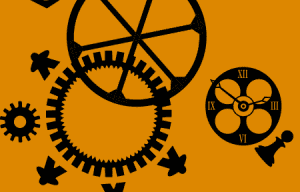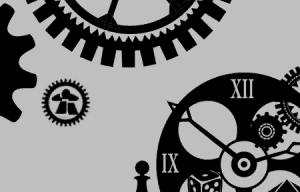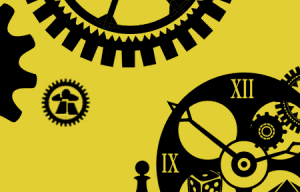
The League of Gamemakers brings you more Kickstarter tips! In our series, Kickstarter Questions, we’ve asked the same 7 questions of project creators who have started and finished a campaign to discover the best practices and common paths to success.
Our next set of questions was posed to this guy named James Ernest. Who is James Ernest you ask? Well:
- He’s designed and published over 100 games and counting under his Cheapass Games label since 1996.
- He has many design accolades, including nominations for dozens of Origin Awards (and he’s even won some!)
- and more to the reason we’re here, his 4 Kickstarter projects have raised over $500,000 combined and each one has done better than the last.
So let’s find out some insights from James – an indie entrepreneur, designer, publisher and successful Kickstarter project creator.
7 KICKSTARTER QUESTIONS
WHAT ARE THE MOST COST EFFECTIVE ADVERT OUTLETS YOU’VE FOUND TO DRIVE FOLKS TO YOUR CAMPAIGN?
Buying advertising for a Kickstarter campaign is a tricky problem. I haven’t really liked any of the options I’ve paid for. I won’t name names, but most of my paid ads have been break-even at best.
By comparison, my free ads seem to do a lot better. Ads on partners’ sites, articles and other press coverage, etc. It’s hard to compare free ads to paid ads on a percentage basis, but I feel like I’ve gotten a better return on my time when I do marketing that’s more personal than a paid banner ad.
I like to get well-known people involved in my game projects, and capitalize on their added reach. The best example is working with Patrick Rothfuss on Pairs; he turned a campaign that could have been about $30k into a huge success, at $323k. More than 80% of my traffic came directly from his blog. Compare that to small single-digit traffic from my paid ads, and you can see why I’m lukewarm on buying banner ads.
NAME YOUR FAVORITE WAY TO ENGAGE BACKERS.
WHEN DO YOU KNOW YOUR GAME IS READY FOR KICKSTARTER?
I won’t launch a project until the game design is finished. Design time is the largest variable, so until the rules are finished there’s no way I would launch a project. If you want to know how to tell if a game is finished, that’s a whole other problem (and the short answer is: make a hundred games and you’ll figure it out).
Recently I’ve decided that I also like to have the art done, or mostly done, before the campaign launches. Art time is not as random a variable as design, but it can still take a while. It can kill the buzz from a campaign if the game takes too long to get to retail stores. More importantly, it’s hard to get backers to imagine what the game will look like. I can show you a mockup, and some sample art by the artist, but it isn’t nearly as representative as the actual game art.
WHAT IS YOUR ACTION PLAN FOR AFTER A CAMPAIGN ENDS?
Short-term the action plan is always: finish the art, do the production, get the game to press, then make the ancillary products. I’m in the middle of that last step with Pairs now. The game is at press, so it’s time to make the stickers, the postcards, the bonus videos, etc. Later today I’m shooting the anchor shot for my “laughing all the way to the bank” video.
Long-term it’s not that active. I don’t have the resources to push existing products, so my time is spent where it can do the most good: new projects. Once a product is printed and shipped, I do a little bit of promotion and marketing, but mostly I just release it into the retail channel and let it sink or swim.
WHAT IS SOMETHING YOU WOULD DO DIFFERENTLY ON YOUR NEXT CAMPAIGN?
WHAT 3 TIPS WOULD YOU GIVE A NEW PROJECT CREATOR?
WHAT’S KICKING AROUND IN THE NEXT YEAR?
This September I’m launching Stuff and Nonsense, which is a revamp of Captain Park’s Imaginary Polar Expedition. It’s a charming tale about a bunch of adventurers who claim to travel the globe, but really just hide in London collecting antiques and stories. Captain Park was a board game, but Stuff and Nonsense is a card game with significantly different mechanics (but a lot of the same card names).
It features Professor Elemental in the Captain Park role, and it’s a deluxe boxed game in the same size box as Unexploded Cow. Along with that game I’ll be reprinting Cow and also printing a new edition of the Cheapass classic card game Give Me the Brain, so there should be some fun stretch goals for those games in the Stuff and Nonsense campaign.
Next Spring I’m going to re-launch Lord of the Fries in a new format. Similar to Pairs, we’ll be releasing the basic Lord of the Fries in a small tuck box (the game’s original format was just 52 cards). As stretch goals, we’ll be adding new restaurants in their own deck boxes, each with new art from Brian Snoddy.
After that plans are a little muddier, as there are some projects with a huge art and/or design load which I will want to tackle before I can put them on the schedule. So imagine some older games with lots of art and you might be able to guess which ones I’m tackling next.
1 BONUS QUESTION, JUST FOR FUN
FILL IN THE BLANK USING THIS CARDS AGAINST HUMANITY CARD: I HAVE AN EVEN BETTER IDEA THAN KICKSTARTER, AND IT’S CALLED _______ STARTER.
I have an even better idea than Kickstarter, and it’s called “Kickblocker.” Backers can donate money to keep projects they hate from ever seeing the light of day.
Kickblocker projects would automatically launch with the same start and end dates as Kickstarter projects, and the Kickblocker funds would be automatically added to the basic funding goal for the Kickstarter project. If you are Kickblocked, you are required to donate the Kickblocker money to charity, and then spend three months not launching a new campaign while you think about what you’ve done. (I’m pretty sure that’s a CAH card.)
—
James Ernest is president of Cheapass Games, making free, cheap and crowdfunded games since 1996. If you don’t know Cheapass Games, there’s a great ‘about us’ section which covers good info on indie publishing as well as design theory articles from James AND you can download dozens of FREE games!
James Ernest will be at Gen Con, speaking at various seminars and panels, and showing off Cheapass games around the con. Stay tuned at the League of Gamemakers for more info about his scheduled talks!
More Kickstarter Questions here!
—
If you have crowdfunded a successful campaign and would like to participate in our KS Questions, send us an email! – we’d love to hear and publish your answers and tips.








